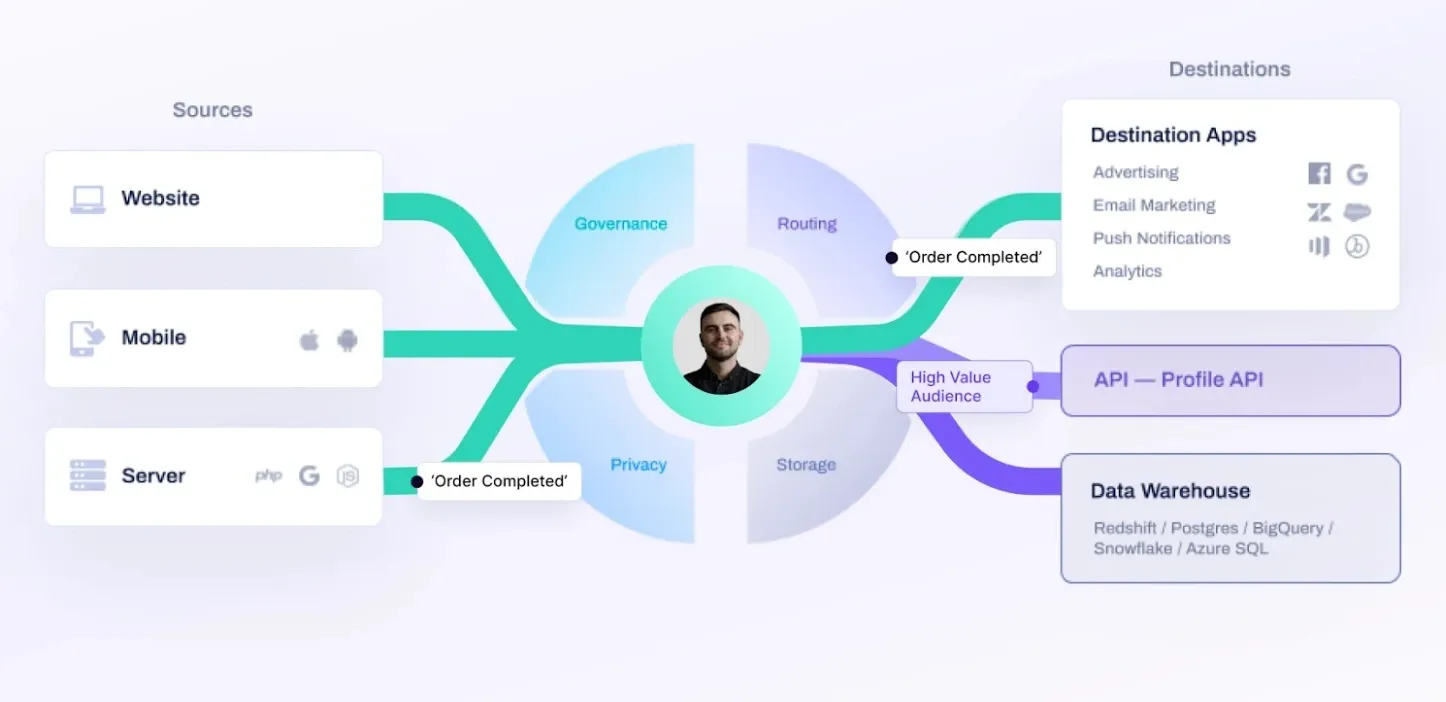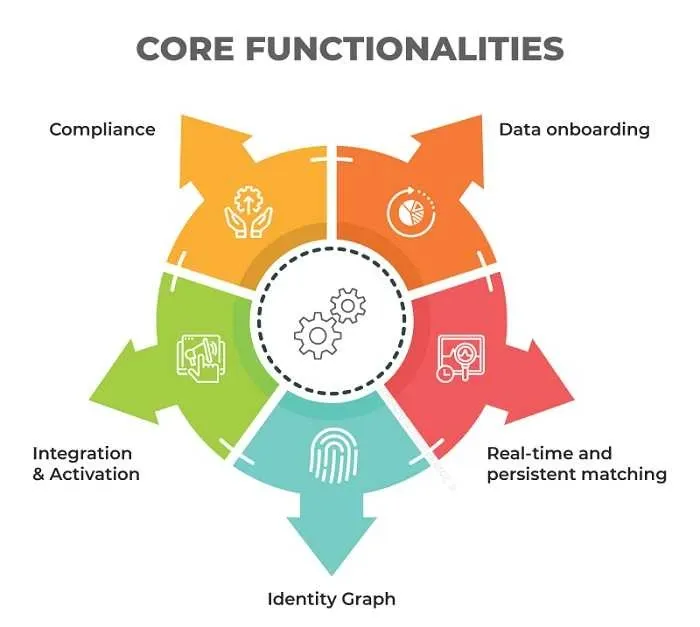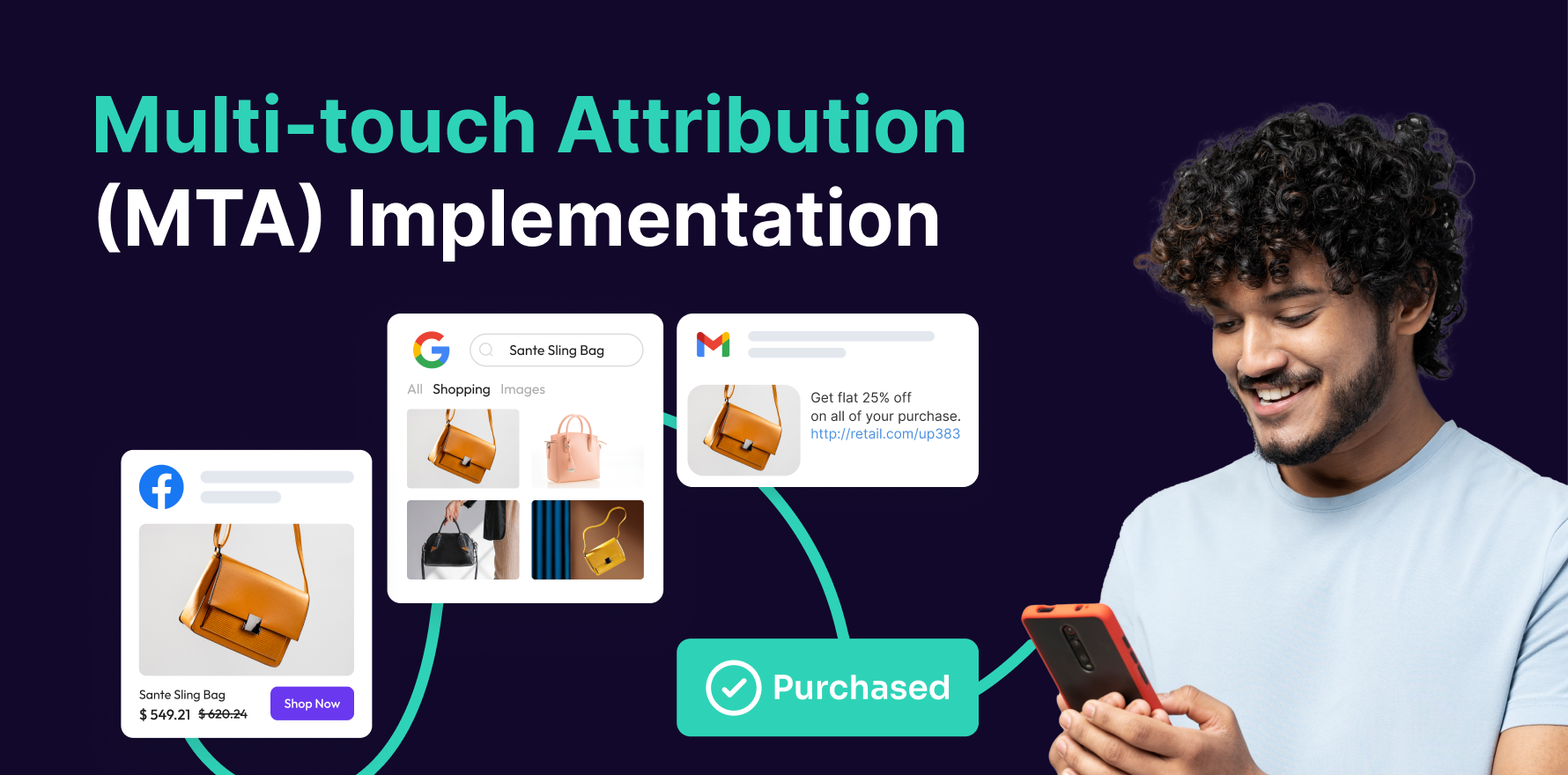Omnichannel marketing is all about integrating offline and online touchpoints to create a personalized experience for potential customers as they start showing interest in your brand’s offerings.
Suppose a shopper searches for “winter trench coats” from her phone, lands on your website for the first time, browses products, wishlists two coats, and leaves. Then, she downloads your mobile app, continues the search, adds one coat to the cart, and leaves again. Finally, after a week, she clicks on an Instagram ad with the same coat she left in the cart and completes the purchase without leaving the app.
That means converting one new user into a paid customer took four to five touchpoints. So, how do you know which marketing channels, among your website, mobile app, and Instagram, are most effective for this particular customer?
Connecting these dots in omnichannel marketing is challenging. But to optimize customer journeys, you need these data points. More so because 83% of customers are willing to share personal data only if brands create a personalized customer experience.
The concept of identity resolution marketing addresses this challenge as it involves identifying potential customers across channels and associating all user engagements in real-time to help brands create an impactful experience for their niche audiences.
Personalized marketing is the cornerstone of remarkable customer experience, and identity resolution provides accurate data to develop tailor-made customer experiences for attracting high-value potential customers.
The Centrality of Customer Experience
Successful implementation of omnichannel marketing depends on a unified customer view. Think of it as a comprehensive and integrated overview of all customer data across multiple channels (CRM, marketing automation tools, social platforms, and so on) in the same place.
Equipped with insights into the customers’ needs and buying patterns across various channels and touchpoints, as a marketer, it becomes easier to make informed business decisions and personalize customer journeys.
However, achieving a unified customer view comes with a set of challenges.
Developing a Unified Customer View
- Collecting customer information is tricky as most businesses have customer data in multiple databases, which often leads to siloes. Extracting and combining all of these datasets takes weeks and even months.
- To build a unified view, the customer data you are using should pass through several rounds of quality checks to ensure accuracy and authenticity.
- Integrating multiple data points and sources into your unified view dashboard is the most significant challenge requiring the engineering teams’ dedicated effort.
- When data is stored in multiple systems, ensuring security and compliance with all privacy regulations is critical.
While developing a unified customer view is challenging, it is also true that marketers must keep pursuing the customers. Believe it or not, customers don’t know what they want. But they are the biggest ROI-driving factors for your brand.
That’s precisely why brands strive to understand customers more deeply, even in the cookieless future for digital-first brands. The strategic advantages of deep customer understanding are plenty.
For starters, it helps marketers personalize the customer experience.
Suppose a clothing brand named X is confident that all its customers staying in the small town of Mystic in Connecticut prefer store shopping.
However, the latest survey showed that most customers are not satisfied as they don’t prefer going to the physical store every time they want to buy something. Some customers even mention that the store’s mobile app has better stocks, but they cannot place orders online due to delivery restrictions.
So, what does this mean for brand X? It needs to enable online shopping for Mystic-based customers at the earliest and improve its supply chain networks so that customers of this town avail fast delivery benefits.
How did the brand come to these findings? Using deep customer understanding.
Plus, deep customer understanding has several other benefits such as:
- Identifying which touchpoints and channels are effective for individual customer segments
- Which marketing initiatives or channels should be prioritized and which channels are unprofitable and should be paused
- Recognizing the touchpoints responsible for the highest customer churn
Now, what do we mean by customer-centric marketing initiatives that improve engagement?
Let us explain with the real-world case study of Warby Parker, an ecommerce eyeglass brand which dominates the eyeglass market by focusing on customer experience.
Traditionally, eyeglass businesses would concentrate mainly on brick-and-mortar stores. But, Warby took a different approach. One of them is creating an interactive online store where customers could virtually try out glasses using Augmented Reality (AR) technology.
To publicize the offering, it employed a unique, customer-driven omnichannel initiative of sending a lighthearted, well-crafted automated email when a customer tried on glasses at home. If a customer was satisfied, they were prompted to complete the purchase in real-time.
Enhancing Marketing Cohesion
Suppose you run an ecommerce store and use only one social media channel to promote your products and services. You rely on organic social media marketing and don’t run ads. This means tracking down the impact of your organic promotional activities is relatively easy as everything is centralized.
Now, think of a different scenario where your business is expanding. You are running both organic and paid marketing initiatives across multiple channels.
When channels are no longer centralized, the performance of all these campaigns will decide your next steps such as:
- Which channel should you select?
- Which platform to invest in?
- How much budget do you need to allocate to different marketing channels?
Non-integrated marketing cannot create cohesion of different decision-making factors of your business and pushes marketers to make half-baked marketing decisions that lack depth and are not data-driven.
It also lacks cohesion. This means your PPC ad may have a different message compared to the social media ads.
On the other hand, integrated marketing helps you stay consistent and reduces customers’ confusion by projecting the same messaging and value proposition across different marketing channels.
It combines an omnichannel strategy and multi-channel attribution to build a cohesive story for your brand, irrespective of the platforms your customers are using.
What’s more, as per a report, integrated marketing campaigns are 31% more effective than non-integrated marketing campaigns. Let’s explore the reasons.
- Integrated marketing unifies all teams: be it social media marketing, content, and demand gen among others. Unlike non-integrated marketing, where the organic team doesn’t know what the demand generation team is working on, all departments follow a common goal in an integrated team.
- Integrated marketing is affordable. Instead of creating multiple content and visuals for different platforms, it focuses on repurposing the same content into various formats and for multiple platforms. Each time there is a content requirement, you don’t have to create everything from scratch, making it cost-effective and improves productivity by removing inefficiencies.
- Integrated marketing streamlines internal systems and builds an efficient process. With a focus on consistency and fulfilling a common business-centric goal, team members need to build and follow efficient workflows that expedite the process.
Consider the example of the AnyWare campaign by Dominos to streamline the ordering process. Customers struggled to order from the Domino application as there were several confusing steps, like which toppings to pick, which payment gateway to choose, and so on.
With this campaign, Dominos aimed at simplifying the ordering process using integrated marketing. The website shows how customers can order pizza through Apple Watch, texts, Alexa, and Apple Carplay.
Currently, the website acts as the central communication channel for Dominos, and soon after the launch, it received 500K+ visits.
Identity resolution, as a part of integrated marketing efforts, helps businesses to recognize and attract customers who interact with a customer across different touchpoints and ensures a cohesive user journey.
A potential customer might interact with your brand through mobile, desktop, or any other device. Identity resolution marketing aims to help brands develop a 360-degree overview of the customer and their journey to deliver a customized experience across all these touchpoints. By pairing identity resolution with integrated marketing, brands achieve improved customer satisfaction.
Read more: How can advertisers overcome signal loss and identity issues?
Navigating Regulatory Compliance
Every organization today needs to keep privacy at its forefront. The modern marketer also needs to comply with privacy regulations be it GDPR, CCPA, HIPAA, or PCI DSS when collecting customer data to create a personalized experience.
The role of data quality management is critical in identity resolution. An identity resolution solution eliminates data fragmentation and duplicate data entries and ensures data accuracy. Your identity resolution service provider should focus on industry regulations to help your business make informed decisions without compromising data integrity.
Core Components of Identity Resolution
There are five core components of identity resolution:
Core Components of Identity Resolution
1) Data Onboarding:
The purpose of this component is to collect all online and offline customer data and bring it to the system for a holistic overview.
2) Real-time and persistent matching:
Once the data is successfully placed within the customer data platform, the datasets go through phases such as deduplication, data hashing, and suppression.
A single profile is created for each customer that is accessible in real-time and changes with each update.
3) Identity graph:
Identity graphs strengthen the customer profile further and transform it into a digital identifier by enriching the datasets.
By “enriching”, we mean adding more datasets like third-party data, device data, cross-channel data, and cookie data.
At the end, you will have a complete online customer identity that combines third-party and owned datasets.
4) Integration and activation:
The next step is to integrate it with advertising and marketing platforms to activate your campaigns.
5) Compliance:
The identity resolution approach is a consistent process to ensure data compliance with the ever-changing data regulations.
While the core components of identity resolution remain the same, their purposes differ based on the models you opt for.
Exploring Identity Resolution Models
Identity resolution is primarily of two types – probabilistic and deterministic.
- The probabilistic approaches make informed assumptions of the probability to be correct. To reach any conclusions, these models use techniques like identifier graphs. These models primarily based their outcomes on uncertainty.
- A deterministic model also relies on identifier graphs with a higher starting point. The outcomes of this approach are more accurate compared to the probabilistic method.
There are six different identity resolution models based on the above two approaches.
1) Medallion approach
To maintain a high level of accuracy, the Medallion approach uses data transition, ingestion, and enrichment.
2) Real-Time index approach
This identity resolution model focuses on real-time data indexing. It is a deterministic approach that allows immediate query and data matching and the accuracy varies as more profile matching is required.
3) Graph dB-based approach
The Graph dB-based approach stands out for its unique way of handling relationships between data entities. Instead of taking a linear approach, it visualizes the data relationships as nodes and edges and explains the interactions more refinedly.
4) Vector dB-based approach
Using high-dimensional vectors that represent identifiers like email IDs, the Vector dB-based approach stores these vectors in specialized databases to perform similarity searches faster. Vector DB is a flexible model that offers accurate matching with incoming queries. This model is probabilistic; to leverage it fully, use it with the hybrid approach.
5) Blockchain-based approach
The underlying foundation of this model is blockchain’s security feature to conduct identity resolution. Using smart contracts for identity matching, it offers a unique global identifier called Decentralized ID. It is deterministic and applicable to compliance-driven use cases.
6) Hybrid approach
As the name suggests, this identity resolution algorithm combines any two or more of the models described above. As a customized approach, it employs variations of both deterministic and probabilistic methods for identity resolution.
Benefits of Identity Resolution
The central purpose of identity resolution marketing is matching potential customers’ needs with an organization’s existing customer profile database, segmenting the potential customers into distinct categories, and creating tailored experiences.
Some of the benefits of an identity resolution are:
a) Creating a seamless customer experience
Identity resolution enriches your marketing initiatives by creating a unified customer overview. Business teams gain insights into a customers’ demographics, purchase patterns, active devices, and channels.
These insights allow marketers to improve the customer experience by providing personalized interactions and launching campaigns for the right channel at the right time.
b) Ensuring compliance with risk and governance
Identity resolution algorithms support data governance and regulatory frameworks to ensure your organization is committed to consumer privacy and help you win potential customer’s trust.
Identity resolution tools have a built-in consent management feature that simplifies customer’s data preference handling and shares complete control with customers if they want to opt out.
c) Increasing ROI through cross-channel attribution
Identity resolution identifies high-intent potential customers and enables accurate multi-touch attribution. It further reduces redundancy and data overlap in marketing campaigns, resulting in highly converting advertisement campaigns and increasing ROI.
Overcoming Identity Resolution Challenges
Identity resolution is a complex concept, and it takes several rounds of trial and error to develop an identity resolution model that is entirely reliable.
The common challenges related to developing an identity resolution model are:
d) Addressing data fragmentation
There is no one-size-fits-all roadmap for assessing how a customer will interact with your website. They will likely use any or all devices like desktops, tablets, mobile phones, and laptops to visit your website.
The way they interact also varies. While some may visit directly through the website, others land on the website by clicking on a discount ad. All these lead to scattered and fragmented data across different channels with no proper way to track them down.
e) Meeting real-time expectations
Modern customers expect real-time interactions across different marketing touchpoints. But, when it comes to customer data, all brands have are email IDs and phone numbers. There is hardly any concrete information about the customer journey through disjointed systems to analyze and develop specific patterns about their preferences and journeys.
Additionally, connecting a customer’s online and offline activities is difficult due to data silos and the involvement of different applications and identity resolution vendors which makes meeting customer’s real-time personalization expectations challenging.
f) Purchasing and maintaining a new tool stack
While many identity resolution vendors sell DIY identity solutions, the truth is that creating identity graphs on your own is challenging, and first-timers require a lot of handholding from the identity resolution vendors. Creating a basic identity graph using SQL data is possible, but marketers struggle to make the data actionable.
Once you create the customer profiles, the next step is to deliver portable data to different teams so they customize their campaigns and marketing initiatives. Without purchasing and maintaining a large tool stack (that includes storage, martech, support, CRM, and other tools), configuring the underlying insights from an identity graph is impossible.
On the other hand, by introducing so many identity resolution vendor tools in the mix, you’ll invite complexity as these tools need set-up, maintenance, timed updates, and a huge investment.
Best Practices for Identity Resolution Implementation
1) Selecting the suitable model for your business needs
Select one or more from the identity resolution models. Choose the identity resolution approach based on your business needs.
For example, in situations where high accuracy is non-negotiable like strengthening organizational security or identifying cyber fraud, the deterministic model works best. On the other hand, in marketing and customer relationship management scenarios where accuracy is preferable but not critical, a probabilistic model is more suitable.
2) Importance of continuous monitoring and updating
Identity resolution is more of a journey, not a destination. It is a long-term process that requires consistent monitoring and updating of the system from time to time as per changing regulations and technological trends.
The best ways to monitor your identity resolution initiatives are:
- Defining key metrics and measurement standards to estimate the success of your efforts
- Reviewing the outcomes from the identity resolution software regularly for new patterns
- Incorporating feedback from stakeholders for future reports
3) Use an automated identity resolution software
Unlike manual identity resolution that takes days to connect to data sources and weeks to create customer profiles, automated idnetity resolution software tool connect with data sources within minutes.
Automated identity resolution capabilities include handling a large volume of data, creating real-time customer profiles and unified views, and ensuring security measures.
Lifesight is a first-party identity graph software offering:
- Real-time, automated identity graphs
- Maps customer identities with marketing initiatives
- Retargets anonymous users to recover and grow sales revenue
- Integrates with a consent management platform
Conclusion
If you’re a forward-thinking marketer looking to implement personalized marketing campaigns and show your stakeholders a high ROI from the marketing spend, identity resolution is for you.
While the benefits of identity resolution are many, the successful implementation requires identifying the right approach, ensuring data quality, managing compliance, and a cdp identity resolution software to get an identity resolution process up and running.
Looking to convert anonymous website visitors into paid customers?
Request a demo to learn more about Lifesight’s identity solution!
You may also like
Essential resources for your success


























































